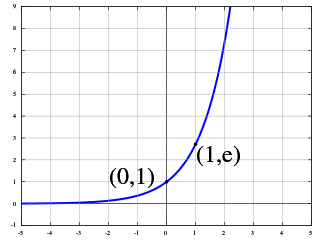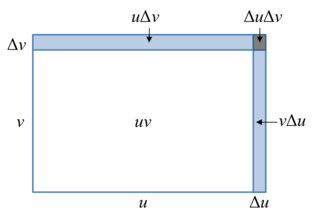Larger domains
One way of defining the exponential function over the complex numbers is to first define it for the domain of real numbers using one of the above characterizations, and then extend it as an analytic function, which is characterized by its values on any infinite domain set.
Also, characterisations (1), (2), and (4) for  apply directly for
apply directly for  a complex number. Definition (3) presents a problem because there are non-equivalent paths along which one could integrate; but the equation of (3) should hold for any such path modulo
a complex number. Definition (3) presents a problem because there are non-equivalent paths along which one could integrate; but the equation of (3) should hold for any such path modulo  . As for definition (5), the additive property together with the complex derivative
. As for definition (5), the additive property together with the complex derivative  are sufficient to guarantee
are sufficient to guarantee  . However, the initial value condition
. However, the initial value condition  together with the other regularity conditions are not sufficient. For example, for real x and y, the function
together with the other regularity conditions are not sufficient. For example, for real x and y, the function

satisfies the three listed regularity conditions in (5) but is not equal to  . A sufficient condition is that
. A sufficient condition is that  and that f is a conformal map at some point; or else the two initial values
and that f is a conformal map at some point; or else the two initial values  and
and  together with the other regularity conditions.
together with the other regularity conditions.
One may also define the exponential on other domains, such as matrices and other algebras. Definitions (1), (2), and (4) all make sense for arbitrary Banach algebras.
Equivalence of the characterizations
The following arguments demonstrate the equivalence of the above characterizations for the exponential function.
Characterization 1 ⇔ characterization 2
The following argument is adapted from Rudin, theorem 3.31, p. 63–65.
Let  be a fixed non-negative real number. Define
be a fixed non-negative real number. Define

By the binomial theorem,

(using x ≥ 0 to obtain the final inequality) so that:

One must use lim sup because it is not known if tn converges.
For the other inequality, by the above expression for tn, if 2 ≤ m ≤ n, we have:

Fix m, and let n approach infinity. Then

(again, one must use lim inf because it is not known if tn converges). Now, take the above inequality, let m approach infinity, and put it together with the other inequality to obtain:

so that

This equivalence can be extended to the negative real numbers by noting  and taking the limit as n goes to infinity.
and taking the limit as n goes to infinity.
Characterization 1 ⇔ characterization 3
Here, the natural logarithm function is defined in terms of a definite integral as above. By the first part of fundamental theorem of calculus,

Besides, 
Now, let x be any fixed real number, and let

Ln(y) = x, which implies that y = ex, where ex is in the sense of definition 3. We have

Here, the continuity of ln(y) is used, which follows from the continuity of 1/t:

Here, the result lnan = nlna has been used. This result can be established for n a natural number by induction, or using integration by substitution. (The extension to real powers must wait until ln and exp have been established as inverses of each other, so that ab can be defined for real b as eb lna.)




Characterization 1 ⇔ characterization 4
Let  denote the solution to the initial value problem
denote the solution to the initial value problem  . Applying the simplest form of Euler's method with increment
. Applying the simplest form of Euler's method with increment  and sample points
and sample points  gives the recursive formula:
gives the recursive formula:

This recursion is immediately solved to give the approximate value  , and since Euler's Method is known to converge to the exact solution, we have:
, and since Euler's Method is known to converge to the exact solution, we have:

Characterization 1 ⇔ characterization 5
The following proof is a simplified version of the one in Hewitt and Stromberg, exercise 18.46. First, one proves that measurability (or here, Lebesgue-integrability) implies continuity for a non-zero function  satisfying
satisfying  , and then one proves that continuity implies
, and then one proves that continuity implies  for some k, and finally
for some k, and finally  implies k = 1.
implies k = 1.
First, a few elementary properties from  satisfying
satisfying  are proven, and the assumption that
are proven, and the assumption that  is not identically zero:
is not identically zero:
- If
 is nonzero anywhere (say at x=y), then it is non-zero everywhere. Proof:
is nonzero anywhere (say at x=y), then it is non-zero everywhere. Proof:  implies
implies  .
.  . Proof:
. Proof:  and
and  is non-zero.
is non-zero. . Proof:
. Proof:  .
.- If
 is continuous anywhere (say at x = y), then it is continuous everywhere. Proof:
is continuous anywhere (say at x = y), then it is continuous everywhere. Proof:  as
as  by continuity at y.
by continuity at y.
The second and third properties mean that it is sufficient to prove  for positive x.
for positive x.
If  is a Lebesgue-integrable function, then
is a Lebesgue-integrable function, then

It then follows that

Since  is nonzero, some y can be chosen such that
is nonzero, some y can be chosen such that  and solve for
and solve for  in the above expression. Therefore:
in the above expression. Therefore:

The final expression must go to zero as  since
since  and
and  is continuous. It follows that
is continuous. It follows that  is continuous.
is continuous.
Now,  can be proven, for some k, for all positive rational numbers q. Let q=n/m for positive integers n and m. Then
can be proven, for some k, for all positive rational numbers q. Let q=n/m for positive integers n and m. Then

by elementary induction on n. Therefore,  and thus
and thus

for  . If restricted to real-valued
. If restricted to real-valued  , then
, then  is everywhere positive and so k is real.
is everywhere positive and so k is real.
Finally, by continuity, since  for all rational x, it must be true for all real x since the closure of the rationals is the reals (that is, any real x can be written as the limit of a sequence of rationals). If
for all rational x, it must be true for all real x since the closure of the rationals is the reals (that is, any real x can be written as the limit of a sequence of rationals). If  then k = 1. This is equivalent to characterization 1 (or 2, or 3), depending on which equivalent definition of e one uses.
then k = 1. This is equivalent to characterization 1 (or 2, or 3), depending on which equivalent definition of e one uses.
Characterization 2 ⇔ characterization 4
Let n be a non-negative integer. In the sense of definition 4 and by induction,  .
.
Therefore 
Using Taylor series,

This shows that definition 4 implies definition 2.
In the sense of definition 2,

Besides,  This shows that definition 2 implies definition 4.
This shows that definition 2 implies definition 4.
Characterization 2 ⇒ characterization 5
In the sense of definition 2, the equation  follows from the term-by-term manipulation of power series justified by uniform convergence, and the resulting equality of coefficients is just the Binomial theorem. Furthermore: [1]
follows from the term-by-term manipulation of power series justified by uniform convergence, and the resulting equality of coefficients is just the Binomial theorem. Furthermore: [1]

Characterization 3 ⇔ characterization 4
Characterisation 3 involves defining the natural logarithm before the exponential function is defined. First,

This means that the natural logarithm of  equals the (signed) area under the graph of
equals the (signed) area under the graph of  between
between  and
and  . If
. If  , then this area is taken to be negative. Then,
, then this area is taken to be negative. Then,  is defined as the inverse of
is defined as the inverse of  , meaning that
, meaning that

by the definition of an inverse function. If  is a positive real number then
is a positive real number then  is defined as
is defined as  . Finally,
. Finally,  is defined as the number
is defined as the number  such that
such that  . It can then be shown that
. It can then be shown that  :
:

By the fundamental theorem of calculus, the derivative of  . We are now in a position to prove that
. We are now in a position to prove that  , satisfying the first part of the initial value problem given in characterisation 4:
, satisfying the first part of the initial value problem given in characterisation 4:

Then, we merely have to note that  , and we are done. Of course, it is much easier to show that characterisation 4 implies characterisation 3. If
, and we are done. Of course, it is much easier to show that characterisation 4 implies characterisation 3. If  is the unique function
is the unique function  satisfying
satisfying  , and
, and  , then
, then  can be defined as its inverse. The derivative of
can be defined as its inverse. The derivative of  can be found in the following way:
can be found in the following way:

If we differentiate both sides with respect to  , we get
, we get

Therefore,

Characterization 5 ⇒ characterization 4
The conditions f'(0) = 1 and f(x + y) = f(x) f(y) imply both conditions in characterization 4. Indeed, one gets the initial condition f(0) = 1 by dividing both sides of the equation

by f(0), and the condition that f′(x) = f(x) follows from the condition that f′(0) = 1 and the definition of the derivative as follows:

Characterization 5 ⇒ characterization 4
In the sense of definition 5, the multiplicative property together with the initial condition  imply that:
imply that:



































































































































